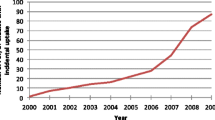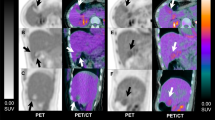Abstract
Purpose
It has been suggested that the use of computed tomography (CT) positive contrast agents has led to attenuation-induced artefacts on 18F-fluorodeoxyglucose positron emission tomography (18F-FDG PET/CT) systems. Consequently, centres may withhold the use of such agents. Whilst there is theoretical evidence to support the aforementioned claim, the clinical relevance of the induced artefacts has not been widely established. Moreover, the potential benefits of bowel enhancement on PET/CT have yet to be formally evaluated. We therefore prospectively examined PET/CT studies to assess whether the use of oral contrast medium induces clinically relevant artefacts and whether the use of these agents is diagnostically helpful.
Methods
Over a 2-month period, 18F-FDG PET/CT images were prospectively reviewed from 200 patients following Gastrografin administration 2 h prior to examination. Both a radiologist and a nuclear medicine physician reviewed the images for contrast medium-mediated clinically relevant artefacts. Artefacts were sought on the CT attenuation-corrected images and were compared with the appearance on non-attenuated-corrected images. The number of examinations in which the oral contrast aided image interpretation was also noted.
Results
There were no oral contrast medium-induced clinically significant artefacts. In 38 of the 200 patients, oral contrast aided image interpretation (owing to differentiation of mass/node from bowel, discrimination of intestinal wall from lumen or definition of the anatomy of a relevant site). In 33 of these 38 patients, the anatomical site of interest was the abdomen/pelvis.
Conclusion
The use of oral contrast medium in 18F-FDG PET studies should not be withheld as it improves image interpretation and does not produce clinically significant artefacts.




Similar content being viewed by others
References
Lardinois D, Weder W, Hany TF, Kamel EM, Korom S, Seifert B, et al. Staging of non-small-cell lung cancer with integrated positron-emission tomography and computed tomography. N Engl J Med 2003;348:2500–7
Wahl RL. Why nearly all PET of abdominal and pelvic cancers will be performed as PET/CT. J Nucl Med 2004;45(Suppl 1):82–95S
Antoch G, Freudenberg LS, Egelhof T, Stattaus J, Jentzen W, Debatin JF, et al. Focal tracer uptake: a potential artefact in contrast-enhanced dual-modality PET/CT scans. J Nucl Med 2002;43:1339–42
Cohade C, Osman M, Nakamoto Y, Marshall LT, Links JM, Fishman EK, et al. Initial experience with oral contrast in PET/CT: phantom and clinical studies. J Nucl Med 2003;44(3):412–6
Antoch G, Jentzen W, Freudenberg LS. Effect of oral contrast agents on computed tomography-based positron emission tomography attenuation correction in dual-modality positron emission tomography/computed tomography imaging. Invest Radiol 2003;38(12):784–9
Nehmeh SA, Erdi YE, Kalaigian H. Correction for oral contrast artefacts in CT attenuation-corrected PET images obtained by combined PET/CT. J Nucl Med 2003;44:1940–4
Antoch G, Kuehl H, Kanja J, Lauenstein TC, Schneemann H, Hauth E, et al. Dual-modality PET/CT scanning with negative oral contrast agent to avoid artefacts: introduction and evaluation. Radiology 2004;230:879–85
Moss AA, Kressel HY, Korobkin M, Goldberg HI, Rohlfing BM, Brasch RC, et al. The effect of gastrografin and glucagon on CT scanning of the pancreas: a blind control trial. Radiology 1979;126:711–4
Giuliano V, Giuliano C, Pinto F, Scaglione M. Rapid CT scan visualisation of the appendix and early acute non-perforated appendicitis using an improved oral contrast method. Emerg Radiol 2004;10:235–7
Dizendorf EV, Treyer V, Von Schulthess GK, Hany TF. Application of oral contrast media in coregistered positron emission tomography-CT. Am J Roentgenol 2002;179 2:477–81
Engel H, Steinert H, Buck A, Berthold T, Huch Boni RA, von Schulthess GK, et al. Whole-body PET: physiological and artefactual fluorodeoxyglucose accumulation. J Nucl Med 1996;37:441–6
Dendy PP, Heaton B. Diagnostic imaging with radioactive materials. In: Dendy PP, Heaton B, editors. Physics for diagnostic radiology. 2nd ed. London: IoP Medical Sciences Series; 1999. p. 163–86
Kinahan PE, Townsend DW, Beyer T, Sashin D. Attenuation correction for a combined 3D PET/CT scanner. Med Phys 1998;25(10):2046–53
Burger C, Goerres G, Schoenes S, Buck A, Lonn AH, Von Schulthess GK. PET attenuation coefficients from CT images: experimental evaluation of the transformation of CT into PET 511-keV attenuation coefficients. Eur J Nucl Med Mol Imaging 2002;29:922–7
Dizendorf E, Hany TF, Buck A, Von Schulthess GK, Burger C. Cause and magnitude of the error induced by oral CT contrast agent in CT-based attenuation correction of PET emission studies. J Nucl Med 2003;44:732–8
Fletcher JG, Johnson CD, Welch TJ, MacCarty RL, Ahlquist DA, Reed JE, et al. Optimization of CT colonography technique: prospective trial in 180 patients. Radiology 2000;216:704–11
Einstein DM, Singer AA, Chilcote WA, Desai RK. Abdominal lymphadenopathy: spectrum of CT findings. Radiographics 1991;11:457–72
Cayea PD, Seltzer SE. A new barium paste for computed tomography of the esophagus. J Comput Assist Tomogr 1985;9:214–6
Thoeni RF, Blankenberg F. Pancreatic imaging. Computed tomography and magnetic resonance imaging. Radiol Clin North Am 1993;31:1085–113
Author information
Authors and Affiliations
Corresponding author
Rights and permissions
About this article
Cite this article
Groves, A.M., Kayani, I., Dickson, J.C. et al. Oral contrast medium in PET/CT: should you or shouldn’t you?. Eur J Nucl Med Mol Imaging 32, 1160–1166 (2005). https://doi.org/10.1007/s00259-005-1833-9
Received:
Accepted:
Published:
Issue Date:
DOI: https://doi.org/10.1007/s00259-005-1833-9




